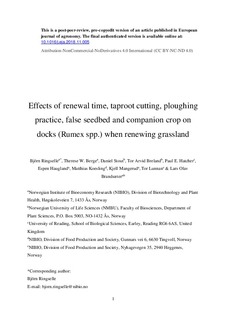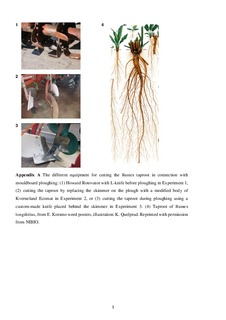| dc.contributor.author | Ringselle, Björn | |
| dc.contributor.author | Berge, Therese W. | |
| dc.contributor.author | Stout, Daniel | |
| dc.contributor.author | Breland, Tor Arvid | |
| dc.contributor.author | Hatcher, Paul E. | |
| dc.contributor.author | Haugland, Espen | |
| dc.contributor.author | Koesling, Matthias | |
| dc.contributor.author | Mangerud, Kjell | |
| dc.contributor.author | Lunnan, Tor | |
| dc.contributor.author | Brandsæter, Lars Olav | |
| dc.date.accessioned | 2019-04-26T12:28:06Z | |
| dc.date.available | 2019-04-26T12:28:06Z | |
| dc.date.created | 2018-12-07T19:15:11Z | |
| dc.date.issued | 2018-12-05 | |
| dc.identifier.citation | European Journal of Agronomy. 2019, 103 54-62. | nb_NO |
| dc.identifier.issn | 1161-0301 | |
| dc.identifier.uri | http://hdl.handle.net/11250/2595731 | |
| dc.description.abstract | Docks (Rumex spp.) are a considerable problem in grassland production worldwide. We investigated how different cultural management techniques affected dock populations during grassland renewal: (I) renewal time, (II) companion crop, (III) false seedbed, (IV) taproot cutting (V), plough skimmer and (VI) ploughing depth. Three factorial split-split plot experiments were carried out in Norway in 2007–2008 (three locations), 2008–2009 (one location) and 2009 (one location). After grassland renewal, more dock plants emerged from seeds than from roots. Summer renewal resulted in more dock seed and root plants than spring renewal. Adding a spring barley companion crop to the grassland crop often reduced dock density and biomass. A false seedbed resulted in 71% fewer dock seed plants following summer renewal, but tended to increase the number of dock plants after spring renewal. In some instances, taproot cutting resulted in less dock biomass, but the effect was weak and inconsistent, and if ploughing was shallow (16 cm) or omitted, it instead increased dock root plant emergence. Fewer root plants emerged after deep ploughing (24 cm) compared to shallow ploughing, and a plough skimmer tended to reduce the number further. We conclude that a competitive companion crop can assist in controlling both dock seed and root plants, but it is more important that the renewal time is favourable to the main crop. Taproot cutting in conjunction with ploughing is not an effective way to reduce dock root plants, but ploughing is more effective if it is deep and a skimmer is used. | nb_NO |
| dc.description.abstract | Effects of renewal time, taproot cutting, ploughing practice, false seedbed and companion crop on docks (Rumex spp.) when renewing grassland | nb_NO |
| dc.language.iso | eng | nb_NO |
| dc.subject | Cover crop | nb_NO |
| dc.subject | Plow skimmer | nb_NO |
| dc.subject | Plowing depth | nb_NO |
| dc.subject | Rumex longfolius | nb_NO |
| dc.subject | Rumex obstusifolius | nb_NO |
| dc.subject | Rumex crispus | nb_NO |
| dc.title | Effects of renewal time, taproot cutting, ploughing practice, false seedbed and companion crop on docks (Rumex spp.) when renewing grassland | nb_NO |
| dc.type | Journal article | nb_NO |
| dc.type | Peer reviewed | nb_NO |
| dc.description.version | acceptedVersion | nb_NO |
| dc.rights.holder | © 2018 Elsevier B.V. All rights reserved. | nb_NO |
| dc.subject.nsi | VDP::Landbruks- og Fiskerifag: 900 | nb_NO |
| dc.source.pagenumber | 54-62 | nb_NO |
| dc.source.volume | 103 | nb_NO |
| dc.source.journal | European Journal of Agronomy | nb_NO |
| dc.identifier.doi | 10.1016/j.eja.2018.11.005 | |
| dc.identifier.cristin | 1640542 | |
| dc.relation.project | Norges forskningsråd: 176812 | nb_NO |
| cristin.unitcode | 7677,3,0,0 | |
| cristin.unitcode | 7677,1,0,0 | |
| cristin.unitname | Divisjon for bioteknologi og plantehelse | |
| cristin.unitname | Divisjon for matproduksjon og samfunn | |
| cristin.ispublished | true | |
| cristin.fulltext | postprint | |
| cristin.qualitycode | 1 | |

